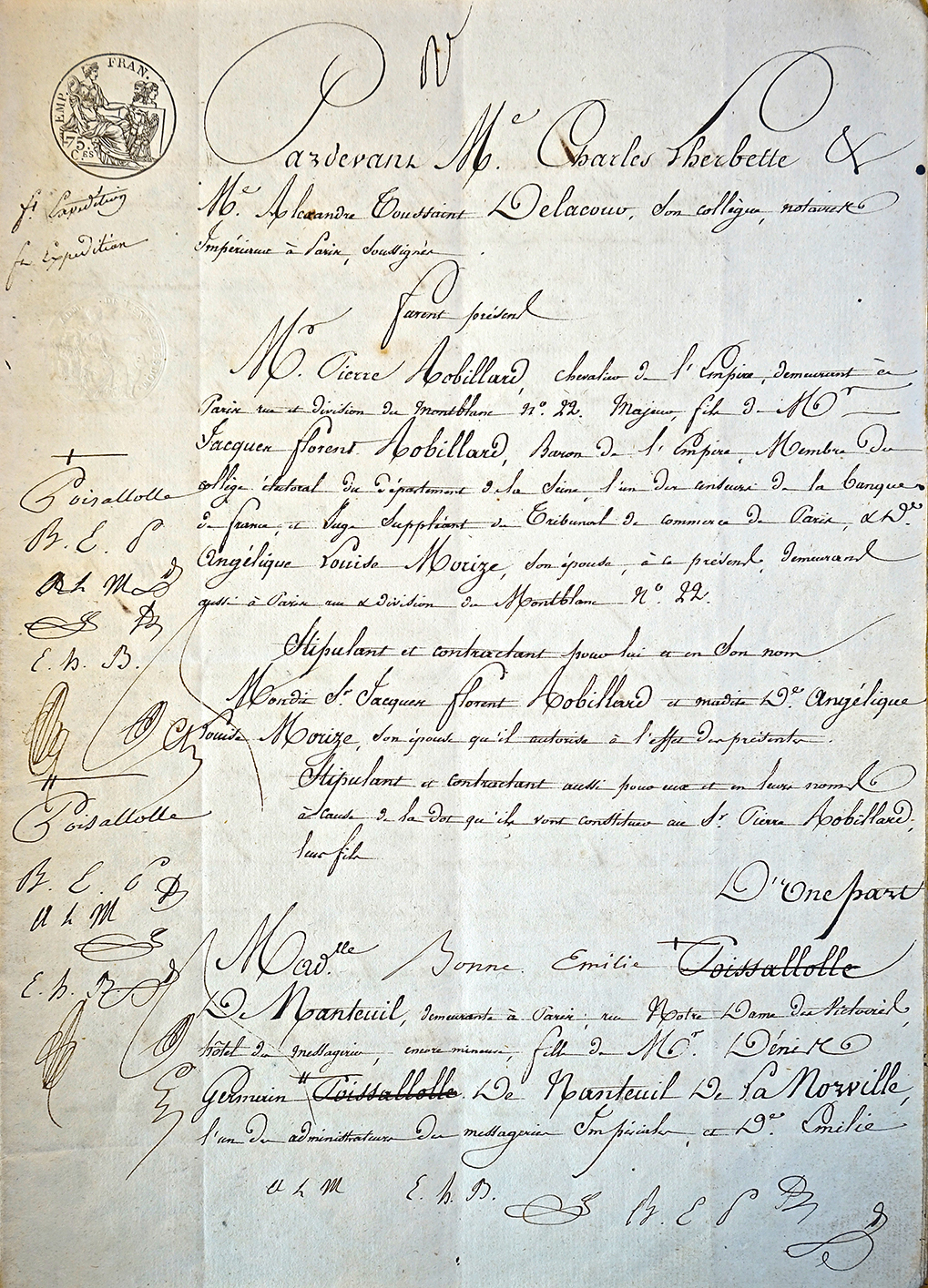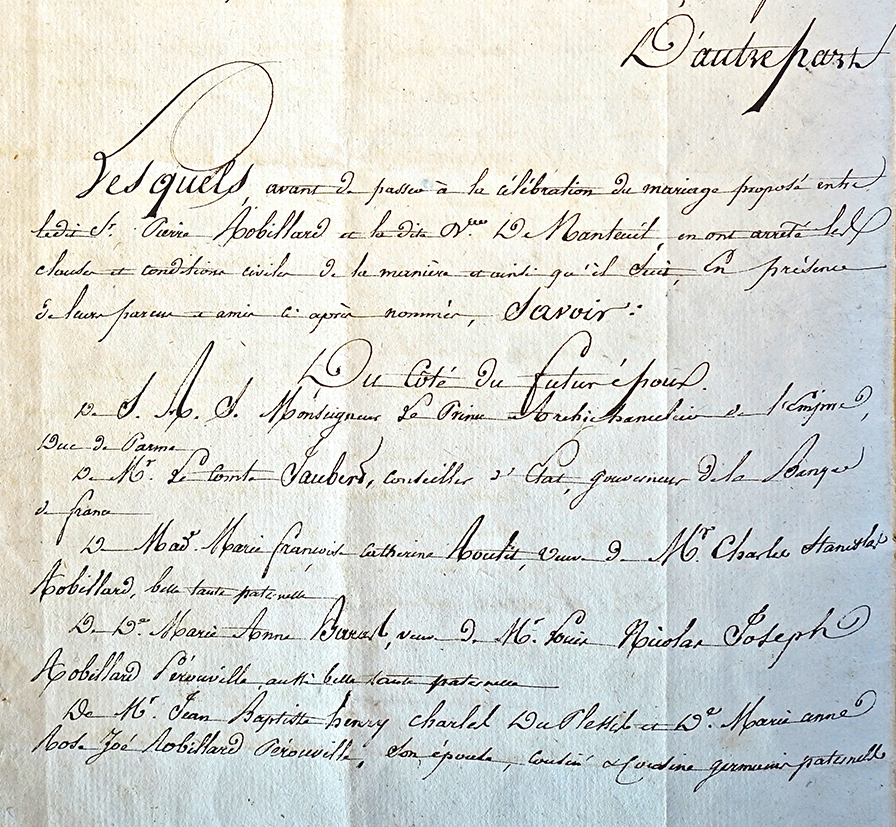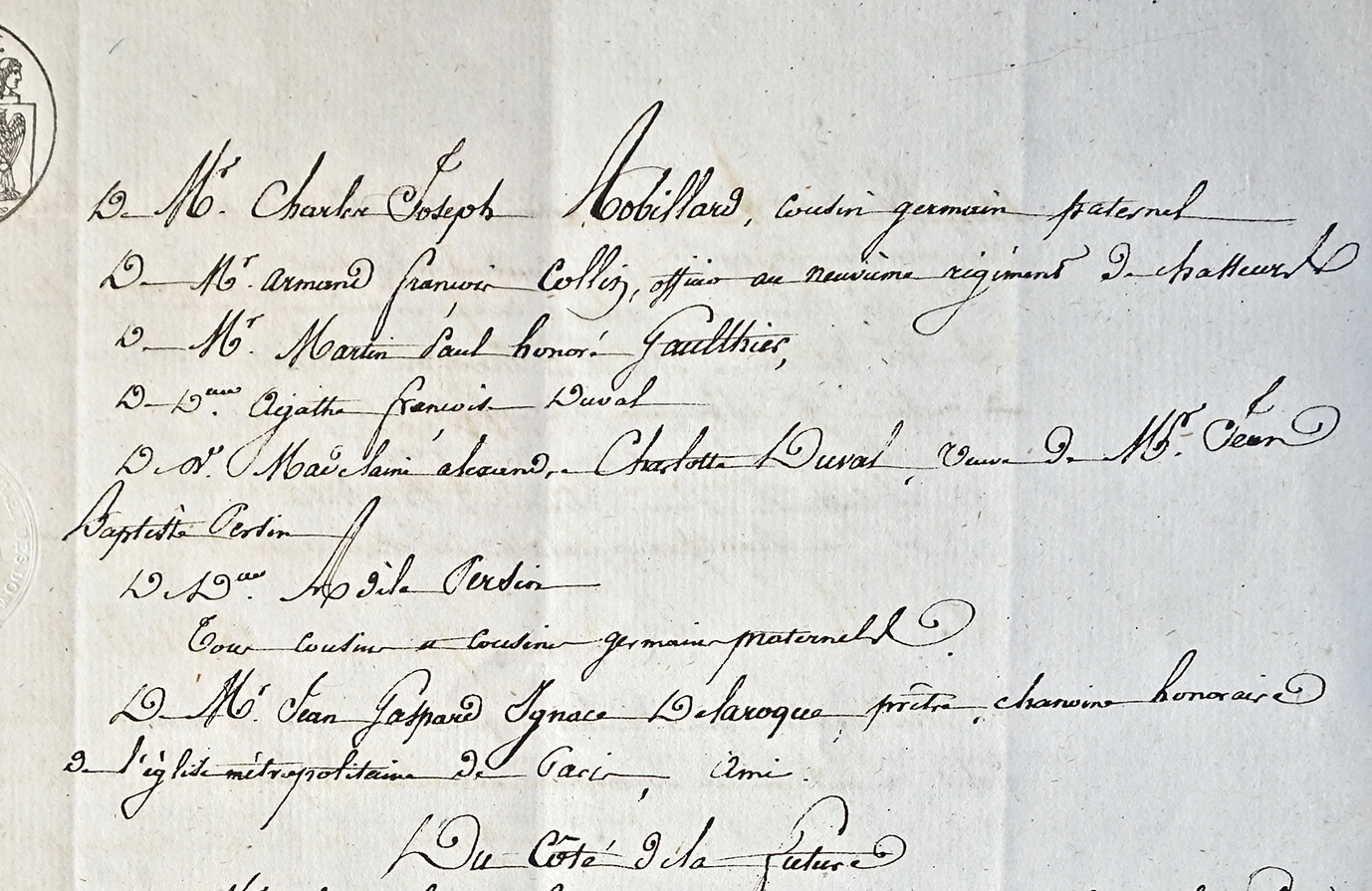1811 Marriage Pierre Robillard & Bonne Emilie de Nanteuil
Géricault Life
Mariage – Mr. Robillard & Madlle. De Nanteuil, December 12, 1811 (detail), MC/ET/LXXV/985 – Archives Nationales (France)
1811 Robillard & de Nanteuil (de la Norville) Families
The marriage of Pierre Robillard and Bonne Emilie de Nanteuil in Paris on December 12, 1811, unified two families who played important roles in the life of Théodore Géricault. We have discussed the impact of Théodore Géricault’s Robillard relations on Géricault extensively in this magazine. The family of Bonne Emilie de Nanteuil was part of the Robillard family for roughly a year. We have not yet discussed the de Nanteuil (de Lanorville) family in any detail, but have briefly discussed messageries (stagecoachs and mail), the de Nanteuil de Lanorville family business, in the art of Théodore Géricault and at the Hôtel de Longueville, one of the Géricault family residences and places of business in Paris.
We will briefly discuss the de Nanteuil de Lanorville family in this article. Our main focus, however, remains on Théodore Géricault’s Robillard relations – in particular what the marriage contract uniting the Robillard and de Nanteuil famlies in December of 1811 tells us about Géricault’s extended family during this crucial period in Géricault’s short life. We begin with a short summary of events leading up to this marriage. (For more detail see other articles in our October 2022 issue.)
Background
In December, 1811, Théodore Géricault was well into his career as an aspiring artist. Géricault was then studying with Pierre Narcisee Guérin, formally or informally according to different reports. Géricault lived with his father Georges Nicolas Géricault in apartments at n° 8 rue de la Michodière in a home owned by Charles Biancour, one of Géricault’s father’s former employers in the family tobacco enterprise.
Jacques Florent Robillard, a key Géricault relation, a banker, and the father of Pierre Robillard, was enobled on October 25, 1810, as the Baron Magnanville, months before Napoleon re-imposed the government’s monopoly on the importation, manufacture, and sale of tobacco products on December 29, 1810 – forcing Géricault’s family and others out of the tobacco business. In 1807, Théodore’s uncle Jean Baptiste Caruel, immensely rich and one of the family tobacco firms original partners, married Alexandrine Modeste de Saint Martin, a young woman possessing an aristocratic pedigree but little wealth, and together produced two sons. Théodore Géricault was godfather to their second son: Paul Caruel, who was born in Paris on December 8, 1809.
After a brief respite in 1802-1803, France was again at war with nations across Europe, but the Emperor Napoléon was still enjoying success. In the fall of 1811, after a period of mixed blessings, the failure of the Musée français, the family art business; the dissolution of the family tobacco enterprise; and the deaths of key family members, including Théodore’s mother in 1808, Théodore Géricault and his family were ready for some good news – the marriage of Pierre Robillard and Bonne Emilie de Nanteuil that December promised exactly the sort of bright future and stability all family members sought. This dream we now know came crashing down when Pierre Robillard was killed by a pistol shot in the Bois de Boulogne on April 8, 1812.
Marriage Contract: Pierre Robillard & Bonne Emilie de Nanteuil

Mariage – Mr. Robillard & Madlle. De Nanteuil, December 12, 1811 (detail), MC/ET/LXXV/985 – Archives Nationales (France)
When Jacques Florent Robillard signed the lease to manage the tobacco manufactory at the Hôtel de Longueville in the fall of 1791, Jacques Florent Robillard was only one of several contrôleurs, or managers of the royal tobacco manufactory, and not even the most senior. Twenty years late Jacques Florent Robillard was the Baron Robillard de Magnanville; had helped found the Bank of France and had served as both a régent and censeur (the most senior administrative and supervisory positions) of the bank. His wife Angélique Louise Morize was the Baronnesse de Magnanville and their son Chevalier Pierre Robillard would inherit his father’s title to pass on to his own heirs. This marriage was almost as consequential for the family of Bonne Emilie de Nanteuil. Already wealthy, M. Poisallolle de Nanteuil de Lanorville and his relations would enjoy the benefits of the Robillard de Magnanville family’s rank and social status from that point forward. Bonne Emilie de Nanteuil would later add the title Baronnesse Robillard de Magnanville to her own family name.
Robillard Guests – Cambacérés and others
The first guest of the Baron Robillard de Magnanville and the most significant individual present by some distance was Son Altesse Sérénissime l’Archiechancelier de l’Empire, duc de Parma Jean Jacques Regis de Cambacérés – still then one of the most powerful figures in France, and of the most significant individuals in French history for his direct role in the design and production in the code civil, a body of law also known as the Napoléonic Code. The second guest of the groom’s family was Francois Jaubert, Governor of the Bank of France. Next, we find Mad. Marie Françoise Catherine Roulit (Roullitt, Roullit), widow of Mr. Charles Stanislas Robillard; Marie Anne Baras (sic) widow of Mr. Louis Nicolas Joseph Robillard Péronville; Mr. Jean Baptiste henry Charles du Plessis and Dame Marie anne Rose Zoé Robillard Péronville.* On the next page we find the name of Charles Joseph Robillard among others.

Mariage – Mr. Robillard & Madlle. De Nanteuil, December 12, 1811 (detail), MC/ET/LXXV/985 – Archives Nationales (France)
Commentary
The presence of Cambacéres, the Duke of Parma and the Count Jaubert, a councillor of State at the wedding of Pierre Robillard and Bonne Emilie de Nanteuil can be seen as the crowning achivement of a family bent on ascending the highest rungs of the social ladder. Proximity to power was nothing new for this generation of Robillards and their wives. Louis Robillard de Peronville’s marriage to Marie Anne Charles de Barras in France’s Antilles colony of Saint Domingue in 1788 conferred the protection of Paul de Barras upon Géricault’s extended family from 1795-1799. Paul de Barras came to power in the Directory in 1795 after deploying his sabre to remove Robespierre the previous year in 1794. There was, however, something of the corrupt cut-throat in Paul de Barras which tainted his ancient family name and those who shared it. Napoleon had replaced de Barras as the most powerful figure in France in 1799; had a much more secure grip on power than de Barras ever wielded; and had only improved that grip as Emperor of France. Proximity to the Emperor by virtue of industry and wealth carried no similar taint.

Mariage – Mr. Robillard & Madlle. De Nanteuil, December 12, 1811 (detail), MC/ET/LXXV/985 – Archives Nationales (France)
Guests of the family of the Groom (continued)
Three additional figures (from the list above) are significant to our understanding of Théodore Géricault in 1811. Two of these individuals are members of the family of Angelique Louise Morize, the mother of the groom. The first is M. Armand françois Collin, officier au neuvième régiment de chasseurs follows that of M. Charles Joseph Robillard. The second is (Anne) Adèle Persin, cousin of the groom. The third is M. Jean Gaspard Ignace Delaroque, prêtre, chanon honoraire de l’église métropolitaine de Paris, friend of the family.
Théodore Géricault presented his first major painting Portrait équestre de M. *** , the Charging Chasseur, at the Paris Salon of 1812, less than a year after his cousin Pierre’s wedding in 1811. Géricault chose for his first major piece an officer of the ninth regiment of chasseurs of the Imperial Guard. Adèle Persin, a niece of Angelique Louise Morize, the Baronness, figures prominently in our next article. We shall address Mlle. Persin’s connection to Géricault then.
Jean Gaspard Ignace De Laroque, priest and honorary canon of the Metropolitan church and “friend” of the Robillard family is, perhaps, the most interesting name on the guest list as far as Théodore Géricault is concerned. The marriage contract Pierre and Bonne Emilie makes no mention of De Laroque’s place of residence and tells us nothing more of the priest’s “friendship” with the Robillards. However, our previous article: Acte de Notoriété Après le Décès de Pierre Robillard, confirm’s Jean Gaspard Ignace de Laroque, priest and honorary canon, was a very special kind of friend to the Robilard family – one who lived at the same address as the Baron and Baronness Robillard, and the Chevalier Pierre Robillard, at n° 22 rue du Mont Blanc in Paris, and who witnessed the death certificate of Pierre Robillard along with Alexandre Toussaint Delacour when Pierre Robillard died in April of 1812.

Mariage – Mr. Robillard & Madlle. De Nanteuil, December 12, 1811 (detail), MC/ET/LXXV/985 – Archives Nationales (France)
Conclusion
Until now, Géricault scholars have been unable to place any member of the clergy within Géricault’s circle of friends and family during the artist’s lifetime. The discovery that Jean Gaspard Ignace De Laroque, priest and friend, did not just reside at the same address as the Baron Robillard de Magnanville and his family, but was present at the marriage of Pierre Robillard and Bonne Emilie de Nanteuil transforms our understanding of Robillard family life in ways hitherto unknown. The significance of Jean Gaspard Ignace de Laroque in the Robillard home and the larger question of Géricault’s attitude toward the church is such that we will examine these questions in greater detail elsewhere.
The participation of Jean Jacques Regis de Cambacérés at the Robillard – de Nanteuil wedding was clearly a tribute to the families involved. None of the guests invited by the de Nanteuil family are of similar or equal rank, not even to that of the Count François Jaubert, Governor of the Bank of France. The presence of an officer of the ninth chaussers may or may not be of special importance to Géricault’s equestrian portrait. The presence of a priest and honorary canon of the Metropolitan church of Paris at the same wedding as Jean Jacques Regis de Cambacérés compels us to point out that de Cambacérés younger brother Étienne Hubert, in 1802, was appointed archbishop of Rouen, Géricault’s place of birth. Géricault was born in Rouen in a home just outside the city walls in close proximity to several different religious houses in the Faubourg Bouvreuil.
The marriage contract of Pierre Robillard and Bonne Emilié de Nanteuil, we noted, was fairly straightforward in respect to property. The most significant cash contribution was the Baron and Baronness Robillard de Magnanville’s promise to provide four-hundred thousand francs to the couple towards the purchase of their own residence, effectively void in the event of the death of the groom prior to his parents, or the lack of children in the marriage. M. Poisallolle de Nanteuil De Lanorville contributed a quarter of this amount. We will examine the disposition of Robillard family property following the death of Pierre Robillard in our next article.
We conclude by pointing out that Jean Baptiste Caruel and Charles Biancour were not present at this important Robillard family event, and not part of the inner-inner Robillard circle in December, 1811. Jean Gaspard Ignace De Laroque was. The Caruel and Biancour families undoubtably celebrated the Robillard – de Nanteuil marriage in fine form, probably over several days, along with friends and families from both sides of the aisle. The marriage of Pierre Robillard and Bonne Emilie de Nanteuil promised much and was a great cause of joy and celebration throughout the Christmas season and into the new year of 1812. We continue our examination of Géricault’s family in 1811-1812 in our next article.
* We will discuss Zoé Robillard de Peronville and her husband Charles Vigoureaux du Plessis (married 31/11/1809) in a forthcoming article.